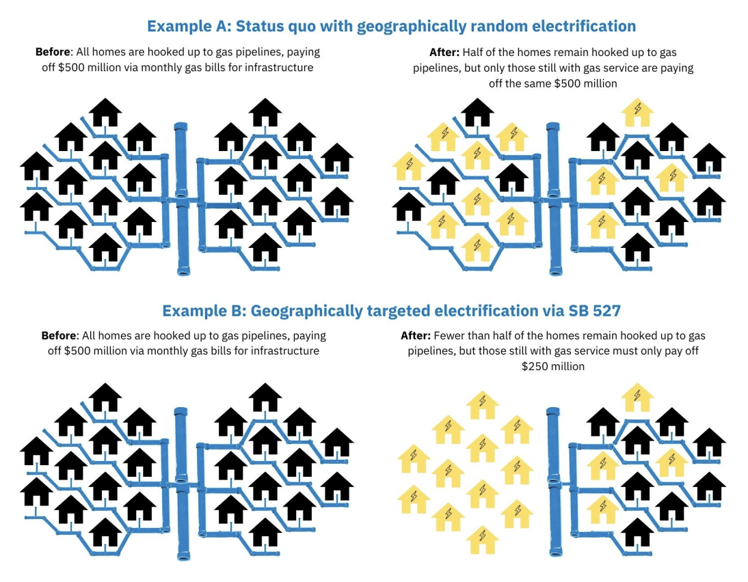 The California legislature has set a goal of net zero by 2045, and dozens of California cities and counties have doubled down on ambitious – but achievable – climate commitments. Meeting that goal will be nearly impossible if homes and businesses in the state remain dependent on fossil fuels for their appliance and energy needs. What’s needed is a process by which the state “fully electrifies” its building stock.
The California legislature has set a goal of net zero by 2045, and dozens of California cities and counties have doubled down on ambitious – but achievable – climate commitments. Meeting that goal will be nearly impossible if homes and businesses in the state remain dependent on fossil fuels for their appliance and energy needs. What’s needed is a process by which the state “fully electrifies” its building stock.
But as any state begins to transition, it is vital for state policymakers to consider the market and infrastructure needs early, and that includes anticipating not only what and where to build new electricity infrastructure, but also working to make sure billions of dollars are not spent building and maintaining fossil fuel systems that are soon to be obsolete. State lawmakers must also prepare for transitions in the workforce and supply chains before significant limitations develop. And, as more homes electrify to reduce or eliminate their gas consumption, fewer customers will be left to foot the bill for growing gas system costs. A strategic and concerted approach is needed to ensure a cost-effective transition, especially for low-income ratepayers, who have the least means to retrofit their homes and are most likely to get stuck with an increasing bill to pay off bad utility investments.
As California progresses toward a future with widespread electrification, it is first necessary to consider the cost implications of an unmanaged transition – that is, the cost of inaction today. The Environmental Defense Fund found that an unmanaged transition away from gas could result in costs 500% higher than a managed one, and, relatedly, impose an additional cost burden on low-income ratepayers. Another study by Energy and Environmental Economics found that California’s gas system costs could be reduced by up to $400 billion by 2050 with a managed gas transition.
What does this mean for California? In order to achieve climate benchmarks in a smart and affordable way, the state must address transition issues strategically and proactively by eliminating regulatory frameworks that both explicitly and implicitly support gas system investment and the limits on electric distribution system infrastructure currently available. In particular, California must address the rising demand for skilled industry workers, electric service, and grid upgrades, and create a process for an equitable down-sizing of gas infrastructure. In response to these needs, there have been a series of bills introduced this year to carry out electrification equitably and efficiently. Though not all will advance in 2023, Advanced Energy United believes each is deserving of serious consideration and near-term action.
Workforce and Market Development
Workforce development, as aforementioned, is essential to attaining clean energy goals. The Department of Energy estimates that the current energy efficiency workforce in California must quadruple by 2030, growing by somewhere between 4,000 to 17,000 workers in order to support the projected national deployment levels of clean energy – including electric building technologies and electric vehicles. For example, while many households are choosing to replace traditional HVAC systems with heat pumps, there is a lack of manufacturers and qualified installers within the United States. It is estimated that on a global scale, the demand for qualified heat pump installers will quadruple by 2030. The workforce shortages to install and manufacture electric building technologies harms consumers, as well as progress towards net zero.
The immense growth needed requires a concerted effort to commit state and federal resources to job training and market incentives. This year, Assemblymember Haney introduced AB 593- Carbon emission reduction strategy: building sector, which works to target various obstacles to electrification. AB 593 requires the California Energy Commission to develop a strategy to address workforce and market development, as well as efforts to reduce financial burdens and barriers to electrification for low-income individuals. Legislation dedicated to planning for clean energy building upgrades, like AB 593, could support 100,000 full-time jobs in the construction industry, as well as 4,900 full-time jobs in manufacturing. On a smaller scale, even just electrifying public schools within Los Angeles County would generate an estimated 400–500 full-time construction jobs. AB 593 signals that California is serious about transitioning to clean buildings in a strategic, thoughtful, and maximally beneficial way.
Electric Grid Readiness
Delayed electric service and grid upgrades have proven to be a major obstacle in customer adoption of clean energy technologies. As more households and buildings install clean energy technologies, the grid, and California’s utilities, must be able to meet the increased demand with reliable, affordable, resilient, and clean energy infrastructure. When customers install a heat pump, electric vehicle charger, solar panel, or home battery, those resources need to be connected to the grid and “energized” by the customer’s local utility. Long delays to energize these new resources also delay the clean air, energy savings, and grid efficiency benefits of high-performing and customer-centric technologies. Accordingly, the interconnection of new technologies must be accomplished within a reasonable time frame and be supported by a robust and reliable grid.
This year, Senator Becker introduced SB 410 - The Powering Up Californians Act, which confronts the need to establish reasonable average and maximum target energization time periods, in addition to reporting requirements for electrical companies to evaluate and improve their performance on energization. Like AB 593, it works to find a solution for the workforce and market demands of electrification by requiring utilities to report current and projected staffing needs. The reporting requirements and energization time periods established within SB 410 center customer experiences and workforce demands as areas needing improvement. These two bills together acknowledge the labor development shortages that accompany widespread electrification while driving towards solutions that facilitate strategic and equitable outcomes.
Neighborhood Decarbonization
SB 527 - The Neighborhood Decarbonization Program, also introduced earlier this year by Senator Becker, would work to phase out gas infrastructure in an equitable manner to avoid placing cost burdens on low-income ratepayers. As more Californians voluntarily electrify their homes , fewer customers will be left paying for the costs of the fossil gas pipeline system. SB 527 seeks to shrink the gas pipeline network as the customer base dwindles and focus electrification programs on the most cost-impacted communities. This legislation is dedicated to an equitable decarbonization strategy by prioritizing the electrification of environmental justice communities and neighborhoods. A key component of this legislation is the waiver of the statutory “obligation to serve” for those within pilot program areas, which refers to a gas utility’s obligation to provide gas to any customer who requests service. SB 527 broadens this into an obligation to provide energy instead of fossil gas. This change prevents an individual from insisting on gas service for luxury products in an otherwise electrified neighborhood, thereby imposing higher costs from inefficient infrastructure with extremely low utilization when more cost-effective and equally performing options (e.g. electric) are available.
SB 527’s approach to decarbonization also benefits the workforce because aggregated neighborhood decommissioning allows for targeted hiring approaches that coordinate with apprentice programs and provide accessible career-track jobs.
 Citation: Senate Bill 527, Advanced Energy United, 2023
Citation: Senate Bill 527, Advanced Energy United, 2023
While this legislation did get held in the Senate Appropriations Committee this year, it remains a promising policy approach towards developing and testing strategies to right-size gas infrastructure in a manner that achieves 100% clean heat and acknowledges both the needs of ratepayers and utilities. Future efforts must similarly include strategies that prioritize low-income ratepayers, and environmental justice communities, as electrification becomes more widespread.
Conclusion
Already there is significant policy momentum for an electrified buildings future in California, with over 50 building electrification mandates statewide. These three bills are examples of the ways in which legislation can help aid California, and potentially other states, equitably and efficiently transition to a fully electrified power sector. Communities too are taking their own actions, with at least 50 California cities and counties committed to winding down the use of gas appliances. By supporting these efforts, in addition to raising awareness of the need for workforce development, well-planned grid upgrades, and right-sizing infrastructure, California can achieve net zero by 2045 in an equitable and cost-effective manner.